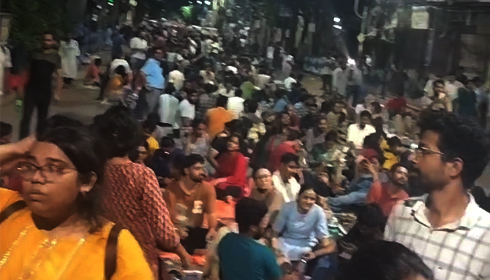
Kolkata Police and Agitating Junior Doctors Soften Stance After Intense Negotiations
Both the Kolkata police and the agitating junior physicians have shown signs of scaling down from their earlier stated positions after a series of protracted negotiations, suggesting a potential resolution to the stalemate triggered by the barricades being put up by the police at the junction of central aveneue and junior doctors staging a sit-in since yesterday evening. The impasse, precipitated by the recent RG Kar incident, saw hundreds of junior doctors, supported by people from all walks of life to demand justice and action from the police.
A group of 22 doctors arrived in Lalbazar not just to meet with Police Commissioner Vineet Goyal but also to give a strong symbolic message. Carrying a backbone, which has served as a symbol of their movement since Monday, the doctors planned to 'present' it to the commissioner as a harsh reminder of their desire for accountability and justice. Their arrival represented a watershed point in the protests, signalling a move away from street demonstrations and towards direct interaction with the authorities.
A peaceful yet aggressive march distinguished the activities leading up to the Lalbazar assembly. The junior doctors, followed by a large crowd, marched towards Lalbazar, shouting slogans and singing songs like "We Shall Overcome," which reverberated throughout the streets. As the procession approached, police took a significant step by lifting obstacles, allowing the march to get closer to the police headquarters. The authorities saw the removal of physical barricades as an initial indicator of de-escalation.
The doctors formed a human chain to preserve discipline and order among the crowd. This chain, placed immediately ahead of the parade, exhibited the doctors' commitment to nonviolent protest. The removal of barricades from Fierce Lane made the march easier, but there was still a significant 400-meter distance between the demonstrators and Lalbazar. However, they agreed that the remaining demonstrators would wait at a safe distance, while the 22-member group would proceed to Lalbazar.
The negotiations were quite protracted. According to a source privy to the matter, the police, led by Additional Commissioner of Police Santosh Pandey, met with the doctors on Monday night, but both sides failed to meet a common ground. On Tuesday, Pandey launched a new round of talks protesting doctors. During these negotiations, the police reaffirmed their request that the doctors lift their blockade and submit their petition immediately to Lalbazar.
However, the doctors remained firm in their requests, providing three possibilities for the negotiations. The first alternative asked Police Commissioner Vineet Goyal to personally visit the doctors, hear them out and accept the memorandum. The second alternative recommended allowing the doctors to march further towards Lalbazar, up to the intersection of BB Ganguly Street and Bentinck Street, from where a smaller delegation proceed to Police headquarters and would present the memorandum. If neither of the first two alternatives materialised, the third and most severe option demanded Commissioner Vineet Goyal's resignation.
After several hours of contemplation, both parties appeared to soften their positions. While remaining staunch in their demands, the doctors agreed to send a smaller group to Lalbazar, indicating a readiness to compromise to facilitate talks. Meanwhile, the police's removal of the barricades and allowing demonstrators to get closer to Lalbazar signalled a willingness to interact and potentially find a middle ground.
This shift in tone on both sides indicates a critical point in the protests. It indicates a shared understanding of the importance of de-escalating conflicts and finding solutions via communication rather than confrontation. The coming days will be critical in determining whether these initial efforts to reach an agreement will result in a peaceful resolution or if additional conversations are required.
As Kolkata and the nation wait with bated breath, the softening postures of both the agitated junior doctors and the police provide a ray of hope for a peaceful resolution. The symbolic gestures, nonviolent protests, and fresh negotiations all demonstrate a shared commitment to justice and accountability. However, the future of these negotiations and both parties' ability to resolve the complaints that have led them to this critical juncture remain uncertain.